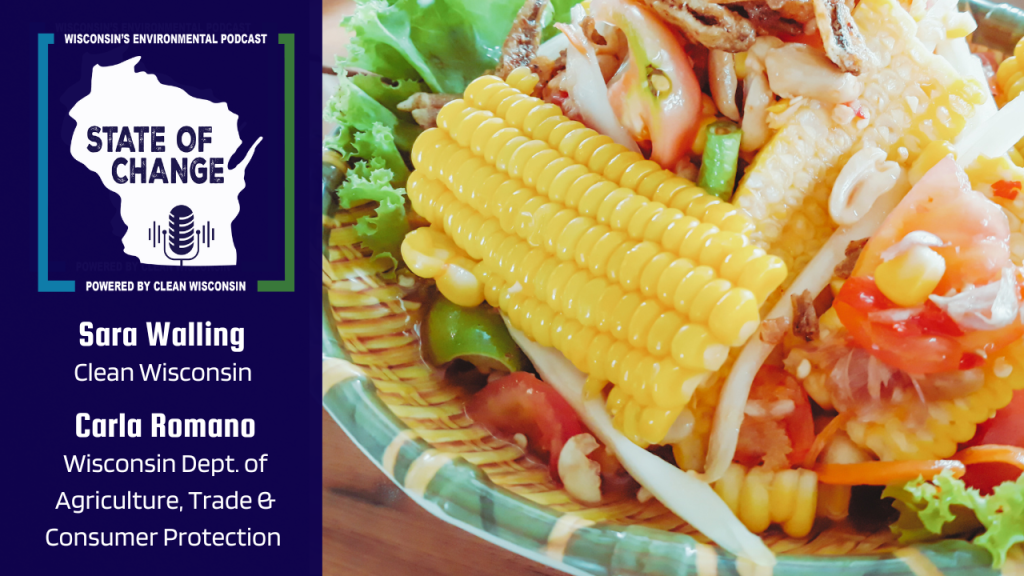The Hidden Threat of Neonicotinoids in Wisconsin
For the past 25 years, we’ve been putting neurotoxins on our food. Neonicotinoids are potent chemicals that attack the central nervous systems of insects. Not only are they on our food and in our soil, they’re showing up in our drinking water in Wisconsin. And that leads to a big what do they do to us?
In this episode, Amy uncovers the truth about neonicotinoids with experts from Clean Wisconsin and the Department of Agriculture, Trade and Consumer Protection.
Host:
Amy Barrilleaux
Guests:
Sara Walling, Water & Agriculture Program Director, Clean Wisconsin
Carla Romano, Groundwater Specialist, Department od Agriculture Trade and Consumer Protection
Background Reading:
Understanding the Impact of Neonicotinoid Insecticides
Agricultural Chemicals in Wisconsin Groundwater Report, Department of Agriculture Trade and Consumer Protection
Neonitcotinoids and their impacts
Where to Listen:
Transcript:
Amy: Studies show neonicotinoids are linked to the disappearance of bees and monarchs in the Midwest. But they are more popular than ever used on a long list of food. Corn, soybeans, forage for livestock, cereal grains like barley, oats, rye and wheat, potatoes, vegetables, and cranberries. You can also find them on lawns and gardens, golf courses and pet collars. But there is growing evidence that the chemicals we just can’t stop using hurt more than insects. Joining me is Clean Wisconsin Water and Agriculture Program Director Sara Walling. Explain to us, I guess, in simple terms, what neonics are and why you and Clean Wisconsin, and a whole lot of other folks are concerned about them.
Sara: So, neonicotinoids are a class of pesticides that are used in a ridiculously widespread manner, not just in the United States, but globally. They are a class of chemicals and pesticides that are neurotoxins to insects and invertebrates. So the intention is certainly for them to kill the bugs that would otherwise harm our agricultural crops. So at this point in time, neonicotinoids are by far the most used pesticide in this country and globally. Neonics are used in a number of applications for seed treatment and both foliar sprayed so on plants themselves, as well as in soil treatment. And so those three uses really encompass nearly 100% of the corn that’s grown in the United States, for example. So a farmer cannot find a conventional seed corn to plant in their field in the United States or in Wisconsin that isn’t already treated with one of these neonicotinoid chemicals.
Amy: So these neonics, as we can call them for short, are widespread. They are neurotoxins. They’re put on all kinds of crops all across the state. And it’s my understanding that we’re starting to see them, or have maybe for a long time been seeing them, in our drinking water supplies. What’s been going on with that?
Sara: Right. So as with most products that are used in agricultural operations, the intent is for them to, you know, impact the target species or the plant that’s there, nurture the agricultural crop, but with too many agricultural chemicals, just like neonicotinoids, they are extremely soluble in water and they’re also really persistent in soil. So what that means is these neonicotinoids can be placed on the seed or sprayed on the plant, and then they move through the water down into our groundwater, potentially running off the surface and surface runoff to our lakes and streams and rivers, or down a little bit into the soil and then laterally and making their way into our streams and rivers in that way. So we have been finding them in the last five or ten years or so in a number of those water systems, streams, lakes and rivers, as well as our groundwater and drinking water systems in Wisconsin.
Amy: And right now it seems like, okay, we know that these chemicals are out there. We know they’re kind of all around us. They’re used in our food crop production, used in all kinds of places. What we don’t know is how that’s really impacting us. How well studied are these chemicals when it comes to human, health impacts or health impacts of other kinds of species?
Sara: So the actual, the base science of understanding how these neurotoxins affect insects is really well studied. Many species are highly impacted by just really, really minute amounts of these chemicals. So that piece has been really well studied. The, um, off site movement of these chemicals and the impacts to non target species of other insects or fish, birds, other things that eat these insects that are also impacted by neonics purposefully. That’s very poorly understood. And lastly, human health implications are really, um, yet understudied. And we’re awaiting new research that is due to come out any day that will help draw more conclusions around neonicotinoid impacts on humans.
Amy: Now, the first that I ever heard of neonics, and maybe that goes for a lot of people, is when, probably 10, 15 years ago, we started to see bees disappearing. And it became clear that these kind of neurotoxin pesticides were messing up the bees’ ability to do their work and, operate their hives and all those things. And at the time I thought, oh, great, we figured that out. And so now we’re going to get rid of these pesticides that are hurting the bees. Why didn’t that happen? Why are we still using these pesticides that we know impact the good insects, the pollinators that we so desperately need?
Sara: Well, there’s certainly been a lot of pressure from pesticide manufacturing companies and the research that they’ve been doing in house to demonstrate a beneficial use for these impacts on our agricultural commodities. Their notion is that by using these, chemicals, they’re reducing the potential for harmful insects to reduce crop yields. And they’ve had some data to demonstrate that. Um, however, really since about 2000 or so, more research has been coming out from independent researchers at Cornell and other places like that that is really indicating that the benefit to even the agricultural pests that the chemicals are intended to influence are not doing their job the way that they need to. And that benefit is far outweighed by the impacts that we’re seeing to our environmental health.
Amy: And you’re saying farmers don’t have like any kind of big choice in this. If I want to go start planting some corn and buy conventional seed corn, it’s going to be coated in this stuff, is that right?
Sara: It is. In 2000, when neonics really first hit the market, they were being used in minimal quantities. But by about 2005, that use really increased. And by 2011, over 40% of our corn crop was, um, coated in the seed treatment. And then by 2014, nearly 100% of seeds used in the United States, to plant our corn, is already treated in this. So it’s very difficult for farmers to even have an option if they chose not to want to plant a neonic treated seed in their field.
Amy: So what needs to happen at this point? I mean, obviously a lot of research needs to happen that wasn’t done before these chemicals got out there on the market. So we’re always like ten steps behind in terms of figuring out the human health impacts of these chemicals. But here in Wisconsin, I know Clean Wisconsin is advocating for some steps to be taken. What is next in your mind in terms of taking on these neonic chemicals?
Sara: Well, one thing I think we need to do nationally, and certainly at the state level too, is increase, our ability to collect data on the use of these neonics. Something happened in 2015, um, at which time the treated article clause of, the Federal Insecticide act, was initiated and applied to these seed treatments, which what that treated article clause means is that companies that manufacture, uh, seed coatings and the use of that neonic in those seed coatings no longer have to report to the EPA how much they’re manufacturing, selling, distributing, or what’s getting used across our Midwest, corn and soybean fields especially. So one thing that’s really a problem is that really by having a lack of that of reporting that this treated article clause created, it’s extremely challenging to study a, chemical and its potential impacts and influences in our ecosystem without understanding how much is out there and how it’s being used. So one of the things that we’re advocating for is certainly, increased reporting at the state and federal level of neonicotinoid manufacture and use across the country, so we can really understand the cause and effect. And then on top of that, I think, strides are being made in other states across the United States, with New York and Vermont being the first two to enact legislation at the state level prohibiting the sale of neonicotinoid treated seed by a certain date and time.
Amy: And so in Wisconsin, we also kind of have our groundwater standards and other standards that we put out for different kinds of chemicals, including agrochemicals. Is there going to be room in kind of, our state work to take on some of these problems?
Sara: So, the top three neonicotinoids used in Wisconsin are already on DNR’s list to enact groundwater standards for those chemicals. They were submitted to the department in 2019. However, a lot of pressure at the legislative level, caused the DNR to pull back rulemaking on these three pesticides. And so they have been essentially, sideboarded for the time being. But the Department of Health Services has done its due diligence to assess the impacts of this chemical in our groundwater systems to understand what’s appropriate and what’s health advisory. So those numbers and the science behind that is already well established, is already available and is in the DNR’s hands to act on. It’s just some really strong roadblocks that the legislative process has established in the last several years that it’s really impeded DNR’s ability and interest to move forward with any regulatory action.
Amy: And is Clean Wisconsin going to be kind of, I guess, pushing on that and saying, hey, DNR legislature, you need to take this seriously.
Sara: Yeah. So, for our part at Clean Wisconsin, we’ve been advocating through the established routes, by connecting with the DNR through their triennial standards review process, to really help influence them to further prioritize the study and regulatory actions around nicotinoid use in Wisconsin in the coming years. And we’ll continue to advocate for that, for increased reporting requirements at the state and federal level, and potentially for seed treatment use restrictions in the coming years.
Amy: So, as water and agriculture program director, I mean, you look at a lot of chemicals, a lot of things that are making their way into our water here in Wisconsin. What is it about neonics that kind of keeps you up at night and makes this a strong focus for you?
Sara: We’re seeing a lot of declines in hexagenia mayflies, which most of us don’t really care about, but our trout and our fisheries do. And the people and the businesses that rely on our fisheries in the state and across the nation and the world really do. I really think this is a class of chemicals that we do not understand nearly enough about their use, their benefits, their implications of use to be continuing to support and promote their use in agriculture widespread. And I find it to be really irresponsible of us as a country to continue to be promoting these chemicals without having an understanding of these really widespread implications.
Amy: Sara Walling with Clean Wisconsin. Thank you for the insight and for working hard to protect our water. I really appreciate it.
Sarah Walling: Thank you. Happy to be here.
Wisconsin testing groundwater for pesticides including neonicotinoids
Amy: The Department of Agriculture, Trade and Consumer Protection, also known as DATCP has been testing private drinking water wells across rural Wisconsin for dozens of different kinds of agrochemicals, including neonicotinoids. Joining me is Carla Romano, a groundwater specialist with DATCP So you’ve got these insecticides, these neonics that kind of came onto the scene in a big way in the early two thousands, widely used at this point in a lot of different applications, but especially in agriculture. What are you finding when you go out and test groundwater and wells in certain areas of Wisconsin for these specific insecticides?
Carla Romano: Yeah, so we have studied testing for nicotinoids back in 2008. So it’s been quite a while now. And you know, since then we have several monitoring programs where we collect samples from private potable wells, monitoring wells as well. And overall we detected, I mean, we collected over 3000 water samples across the state. So out of these 3000 samples we have primarily found three neonicotinoids because there are several compounds that fall within this group and these compounds are clothianid, imidacloprid and thiamethoxam with clothianidine being the most detected compound, neonicotinoid compound of the three. So we have found them in the environment. Uh, but there is definitely a concern in terms of detection. But our concern starts whenever we start comparing our concentration, the concentration at which we found these compounds versus what are the thresholds and the benchmarks from a human health standpoint. And so there are currently no groundwater standards for, established for the neonicotinoids. However, the Wisconsin Department of Health Services or DHS has published some drinking water health advisory levels. And it’s 1000 micrograms per liter, or ppb for clothianidine, uh, 120 ppb for thiamitoxam and 0.2 for imidacloprid And so far we have not detected clothianidin and thiamethoxam in exceedance of these thresholds. However, we have detected for about nine percent of the 3000 samples that we collected, imidacloprid exceedance of the 0.2 micrograms per liter DHS health advisory level for drinking water.
Amy: So why look at these things, in surface water and in groundwater, like our aquifers, there is no groundwater standardization in Wisconsin for these chemicals? There is nobody out there saying, yeah, we have to meet this certain level or concentration in our aquifers in Wisconsin. So, if there’s not that kind of like rule or standard coming down from the EPA or coming down from the DNR, DHS or anybody, then, why bother, I guess, trying to figure out what the concentrations are across Wisconsin?
Carla: Yeah, I mean, it’s kind of a process for, in order for us to understand if a chemical is of a concern, you actually have to start looking for it, right? Like, you can’t just stop testing and say, oh, everything is good, and assume that everything is all right. So I feel we always start with like, you know, testing and understanding. Again, if a pesticide is found and then whenever it’s found, then we communicate that with DHS and say, hey, okay, can you tell us pretty much what is a concerning level for these compounds? And then those DHS health advisory levels then eventually could become like groundwater standards with the update of the Wisconsin statute, NR 140, which established the groundwater quality and therefore groundwater standards. However, that is a process that it’s kind of managed by the Wisconsin DNR. But we work closely with DHS and DNR to kind of work through the whole process. And I mean, we at this point anticipate that in the next year or so there might be some proposed standards for neonicotinoids. So there might be an update of the NR 140 for groundwater quality and therefore the potential inclusion in the nr 140 of the neonicotinoids, at least for the three neonictinoids that we have detected so far. So, clothianidin, imidacloprid and thiamethoxam, as per dacap, we do have the authority to restrict use of a pesticide. However, um, we can only do it whenever we have an exceedance of a groundwater standard. So, if there are no groundwater standards at this point, we have no authority to ban or restrict the use of a pesticide. So, as you said, unless EPA is going to do something in the next future, then at this point we’ll have to wait that potentially groundwater stands and will be in place before we can actually do something.
Are there areas of Wisconsin that are particularly vulnerable to groundwater contamination?
Amy: As per DATCP are there any areas of Wisconsin that are particularly vulnerable to getting insecticides and herbicides into their drinking water?
Carla Romano: I mean, naturally, there are areas of Wisconsin that are more vulnerable to groundwater contamination. Uh, there is a beautiful map that is actually was published in the late eighties from WGNHs that is still really used by hydrogeologists that kind of combines different factors such as soil type, the water table, and the depth of the water table, and kind of delineate areas of Wisconsin that are at high risk of contamination for several contaminants. And we find that to be true also for neonicotinoids. So we have, for example, areas in the central region of Wisconsin, uh, where we have found these compounds. But we have found neonicotinos also in south central and southwestern Wisconsin. And yeah, considering the last statewide survey, we actually have found only one, pesticide imidacloprid. So one of the neonicotinoids in exceedance of, uh, DHS health advisory level. And that was located in the area of the central sands. So, um, there’s definitely areas that are more vulnerable to groundwater contamination and also to contamination of neonicotinoids in groundwater.
Amy: Do you find that even though neonics got a lot of attention for the bees, um, probably about 20, 15 to 20 years ago, um, that people don’t really seem to start caring until you start talking about human health impacts and that health advisory level. Is that when maybe sometimes people are more interested in the reports or the testing you do?
Carla Romano: I think it’s a mix. recently I was at a conference where the audience was, you know, part of, like, a lot of lake associations. Uh, so it’s. It’s. I think there is a lot of attention also for, like, generally, like, non target species, not only pollinators, but also like, invertebrates, aquatic invertebrates or fish. So, there is a mix. And of course, like, you know, whenever I think it’s kind of in the human mind of saying, okay, if that’s harmful for an inset, what it’s gonna happen to me? So I feel that there is always that kind of, like, follow up question of like, okay, but what about humans? But that doesn’t necessarily mean that I feel people don’t care about the rest of the species. I think it’s just kind of like, just, you know, a human kind of aspect of just worrying about ourselves. Like, okay, but then what does that mean for human health? Um, and again, the main kind of issue, but also it’s not an issue. I mean, it’s more like studies have shown that the main kind of concern, uh, with neonicotinoids is related more to invertebrates and pollinators. However, there have been some studies that show that, uh, there is potential impact on mammals. So that’s why there is some concern related to human health. And, um, DHS, again, has some information related to the impact on human health. But generally speaking, high concentration of clothianidine and thiamethoxam in drinking water might lead to some issues related to blood, kidney and liver. And while instead imidacloprid high concentration of imidacloprid in drinking water might lead to issues more related to glucose regulation or kind of neurological and reproductive issues. So, again, there is some concern related to human health, and I feel people are starting to be informed about that as well. Uh, or all information that are public, to be fair. And there is a lot of conversation happening on both ends not only for human health, but also for other non targeted species.
Amy: All right, well, thank you so much for taking the time to explain all your research and all the background related to these and other agrochemicals. I really appreciate it.
Carla Romano: Yeah, no, thank you for having me. Appreciate that.





